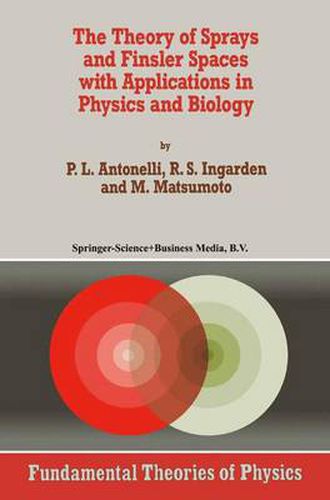Readings Newsletter
Become a Readings Member to make your shopping experience even easier.
Sign in or sign up for free!
You’re not far away from qualifying for FREE standard shipping within Australia
You’ve qualified for FREE standard shipping within Australia
The cart is loading…






This title is printed to order. This book may have been self-published. If so, we cannot guarantee the quality of the content. In the main most books will have gone through the editing process however some may not. We therefore suggest that you be aware of this before ordering this book. If in doubt check either the author or publisher’s details as we are unable to accept any returns unless they are faulty. Please contact us if you have any questions.
This volume presents the principles and methods of sprays (path spaces) and Finsler spaces with many applications in the physical and life sciences. The book has six chapters and an extensive reference section. Beginning from the classical theory of sprays, Chapter 0 presents an introduction to modern Finsler differential geometry. The following three chapters can serve as a comprehensive graduate course using the notions of pre-Finsler connections in spray bundles. Topics covered are the calculus of variations and Finsler metric functions, spaces of constant curvature, projective and conformal geometry, two-dimensional Finsler spaces, Beswald spaces, (alpha, beta)-metrics, etc. Chapter 4 deals with the Finslerian view of dissipative mechanics, thermodynamics and information, and geometrical and electron optics. Chapter 5 discusses, from a Finslerian perspective, ecological problems and models, with particular reference to the Great Barrier Reef. Spray connection theory is shown to be indispensable for a logically consistent theory of social interactions. Projective Finsler geometry and Wagner connection theory are used to model time-sequencing changes in growth and development. Some direct applications to fossil measurements in paleontology are also described. For geometers, physicists and theoretical (marine) biologists, the book can also be recommended as a supplementary graduate text.
$9.00 standard shipping within Australia
FREE standard shipping within Australia for orders over $100.00
Express & International shipping calculated at checkout
This title is printed to order. This book may have been self-published. If so, we cannot guarantee the quality of the content. In the main most books will have gone through the editing process however some may not. We therefore suggest that you be aware of this before ordering this book. If in doubt check either the author or publisher’s details as we are unable to accept any returns unless they are faulty. Please contact us if you have any questions.
This volume presents the principles and methods of sprays (path spaces) and Finsler spaces with many applications in the physical and life sciences. The book has six chapters and an extensive reference section. Beginning from the classical theory of sprays, Chapter 0 presents an introduction to modern Finsler differential geometry. The following three chapters can serve as a comprehensive graduate course using the notions of pre-Finsler connections in spray bundles. Topics covered are the calculus of variations and Finsler metric functions, spaces of constant curvature, projective and conformal geometry, two-dimensional Finsler spaces, Beswald spaces, (alpha, beta)-metrics, etc. Chapter 4 deals with the Finslerian view of dissipative mechanics, thermodynamics and information, and geometrical and electron optics. Chapter 5 discusses, from a Finslerian perspective, ecological problems and models, with particular reference to the Great Barrier Reef. Spray connection theory is shown to be indispensable for a logically consistent theory of social interactions. Projective Finsler geometry and Wagner connection theory are used to model time-sequencing changes in growth and development. Some direct applications to fossil measurements in paleontology are also described. For geometers, physicists and theoretical (marine) biologists, the book can also be recommended as a supplementary graduate text.